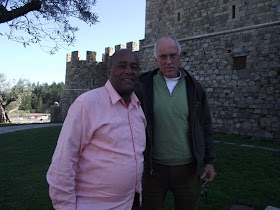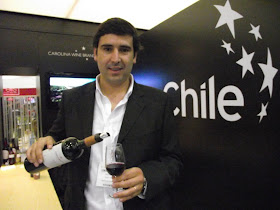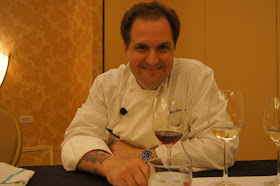Donnafugata wines: Sicilian summer in a glass
Story and photos by Dwight Casimere
1. Old Verona, Italy at Dawn
2. Jose Rallo, owner, Donnafugata wines
3-5 Donnafugata wines at Vinitaly 2011
Marsala, Western Sicily—Summer crush is in full swing at Contessa Entellina, home to Donnafugata wines of Sicily, 75 miles southwest of Palermo. Luscious Chardonnay grapes are being rushed to the crusher in preparation for the new vintage. First pick is the traditional Night Harvest. Known as the Goblet of Stars, it is a festival that celebrates quality wines and the environment.
Jose Rallo, owner of Donnafugata, is an avid jazz enthusiast and singer as well as a winemaker. She routinely sings to the grapes in the field and holds concerts in the aging cellars. She is a one-woman celebration of the intertwined worlds of music and the vine. A cork manufacturer, Amorim Cork, and a tour operator, CTS Viaggi, have been Donnafugata’s partners in promoting sustainable environment.
Along with her husband, Vincenzo Favara, Jose cultivates her great love for music, singing and wine. Over the years, Donnafugata has also hosted concerts by jazz greats Pat Metheny, John Scofield. Her explorations in the synergy between wine and music inspired the CD, Journey to Donnafugata, a jazz arrangement of the music from the film, The Leopard. Donnafugata Music & Wine Live was created in collaboration with friends who were passionate about wine and Brazilian jazz. As producer and solo vocalist, Jose Rallo guides the audience through a multi-sensory experience involving wine tasting to accompanying jazz beats that embody the flavor components of the wine. This formula led to memorable concerts at the Blue Note night clubs in Milan, New York and Beijing and Shanghai, China culminating in the recording this year of the Tasting in Jazz videos in the Donnafugata cellars at Marsala, with Jose singing to the accompaniment of a clarinet and cello. The combined expression of music and winemaking expertise has created some amazing wines!
Premiering her newest wines at Vinitaly 2011 in Verona, the world had the opportunity to taste the latest of Jose’s creations for Donnafugata wines. They are exciting, refreshing wines that are fueled by her passion for music and art.
Each of the new releases features a specially commissioned work of art on the label. Anthilia 2010, Polena 2010, Tancredi 2007 and Sedara 2009 are the ultimate expressions of the winery’s all-encompassing vision.
Anthilia 2010 ($14.29) is a delightful example of the true Mediterranean expression in wine. Made primarily from native Catarratto (51%), Ansonica and other Sicilian grapes, the wine is crisp and complex with strong mineral notes and scents of white peaches and a hint of grapefruit. If Ernest Hemingway had drunk this wine, he might never have asked Harry of the eponymous bar that bears the owner’s name in Rome, to create the Bellini!
Polena 2010 ($16.52) is another white blend, this time of native Catarratto and Viognier from Sicily. This is a great summertime party wine, great for the barbecue or the beach. It refreshing with the smell of flowers and tropical fruits. The crisp taste makes it a great match with seafood appetizers, oysters, shrimp and vegetarian dishes such as pasta primavera or linguine with fresh basil, homemade mozzarella (recipe to follow) and heirloom tomatoes.
The wine bears a painting of ship’s figurehead-‘Polena’ in Italian. The name harkens back to the days of the Rallo family’s origins in wine production in Marsala for more than 150 years.
Tancredi 2007 ($36) is a classic Italian red, with 70% Nero d’Avola and 30% Cabernet. This is a classy, sophisticated wine that speaks to tradition, but with a bold, new interpretation. Rossini’s opera, of the same name, is the composer’s greatest masterpiece. So it is with Donnafugata. Based on a novel by Voltaire, it tells the story of a betrayed revolutionary who wins the battle, but is mortally wounded, dying in his wife’s arms just as they are being married.
Tancredi, the wine, is a hero’s feast in a glass. With its deep, rich, Ruby-red color, its notes of dark chocolate, black cherries and a dramatic hint of bracing mint, it is the very elixir that heroes in the throes of battle, drank on the Elysian Fields. This is an altogether absorbing wine with a commanding structure and regal presence.
Sedara 2009 ($14.99) is as another blend of primarily Nero d’Avola grapes with Cabernet, Merlot and a touch of Syrah for added depth. It’s well balanced with silky tannins. It’s a pleasant wine to drink throughout one of those long, leisurely meals that the Italians are so famous for. The film director, Federico Fellini (8 ½, La Dolce Vita), was said to have served lengthy, multi-course lunches to the cast and crew of his films, complete with a selection of wines. I’m sure a Nero d’Avola antecedent to Sedara, must have been amongst the retinue.
Recipes:
-Homemade Mozzarella
-Dwight The Wine Doctor’s Heirloom tomato pasta with homemade Mozzarella and fresh Basil
Homemade fresh mozzarella cheese has fabulous flavor. The instructions here for making your own at home are detailed but not difficult. Rennet and citric acid can be found in health food stores and specialty markets.
Prep Time: 10 minutes
Cook Time: 20 minutes
Total Time: 30 minutes
Ingredients:
1/2 rennet tablet
1/4 cup cool, chlorine-free water (most bottled waters are chlorine-free)
1 gallon milk (2%, 1%, or skim)
2 teaspoons citric acid
Salt, optional
Preparation:
Crush the rennet into the water and stir to dissolve. Pour milk into a non-reactive pot (no aluminum or cast iron). Place over medium heat. Sprinkle the citric acid over the milk and stir a few times. Heat milk to 88 degrees F. Milk will begin to curdle.
At 88 degrees F, add the rennet solution and continue stirring slowly every few minutes until the milk reaches 105 degrees F. Turn off the heat. Large curds will appear and begin to separate from the whey (the clear, greenish liquid).
With a slotted spoon or mesh strainer, scoop the curd into a large glass bowl. (If it's still too liquid, let it set for a few more minutes). Press the curds gently with your hand and pour off as much whey as possible. Microwave curds on high for 1 minute, then drain off all the excess whey. With a spoon, press curds into a ball until cool. Microwave two more times for 35 seconds each, and continue to drain the whey and work cheese into a ball. In the meantime, place the whey over medium heat and let it heat to about 175 degrees F.
When cheese is cool enough to touch, knead it like bread dough until smooth. When you can stretch it like taffy, it is done. You can sprinkle 1 to 2 teaspoons salt into the cheese while kneading and stretching it. The cheese will become stretchy, smooth and shiny. If it is difficult to stretch and breaks easily, dip it into the hot whey for a few seconds to make it warm and pliable. Then pick it up again and stretch it into a long rope. Fold over and stretch again. Dip in hot whey as needed to make the cheese pliable.
When the cheese is smooth and shiny (this takes just a few minutes), it is ready to eat. Shape it into a log or golf-size balls, then store in a solution of 2 teaspoons salt to 1-cup water.
Note: Citric acid and rennet are available through mail order, some pharmacies or health food stores.
Yield: about 3/4 pound mozzarella cheese (12 ounces)
Dwight The Wine Doctor’s Heirloom tomato pasta with homemade mozzarella and fresh Basil
What you’ll need:
1 lb angel hair or thin spaghetti whole-wheat pasta
1 lb. homemade mozzarella (see above recipe, or shop your local Italian market or specialty grocer
6 Tbs extra virgin olive oil
1 large bundle of fresh Basil (about 5 ozs)
4 Tbs freshly grated Romano cheese per serving
2 cloves fresh garlic
1 small white onion, cut in slivers
Juice from ½ fresh lemon
Freshly ground white pepper
Several pinches of sea salt, one for boiling pasta, the rest to sprinkle on each completely assembled dish
Serves 4
Boil pasta in salted water, about four minutes, while simultaneously sautéing sliced heirlooms or whole grape tomatoes, diced garlic and sliced onions in the olive oil on low flame. (about 4 ½ mins for each)
On each serving plate, place two heaping scoops from a pasta server of the steaming pasta. Cover each with copious amounts of hand shredded Basil. Top with roughly shredded pieces of the homemade mozzarella and the Romano cheese. Sprinkle on hand grated white pepper, sea salt to taste. Douse with dashes of fresh lemon juice and serve with Donnafugata wine of your choice. Play your favorite jazz CD on your iPod, home stereo system, cable provider or mobile device. Abondanza!







































